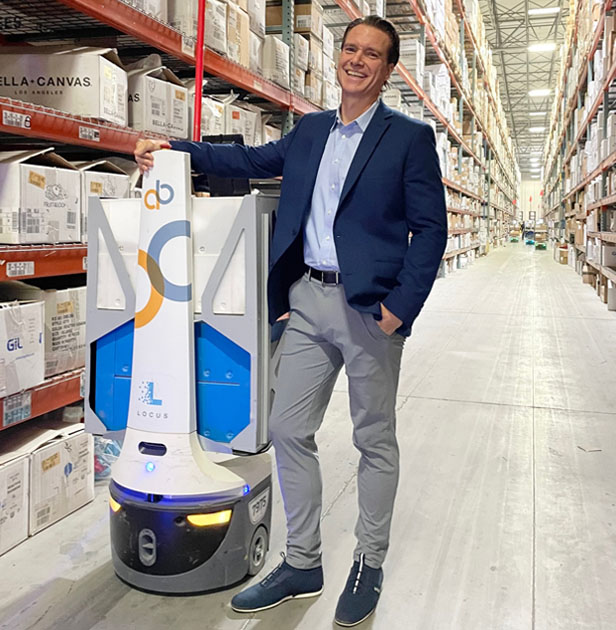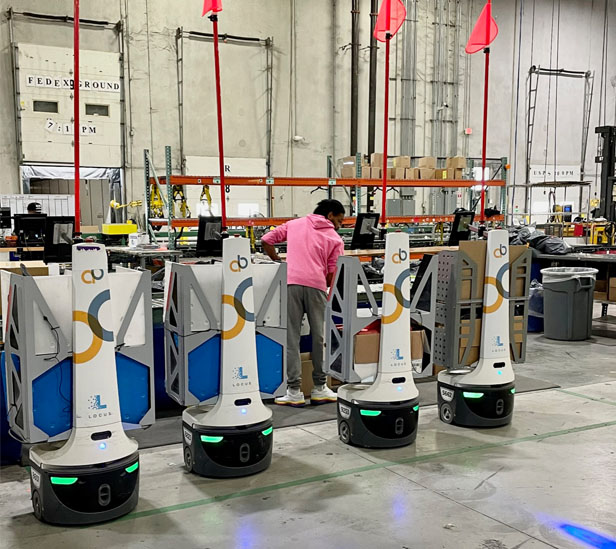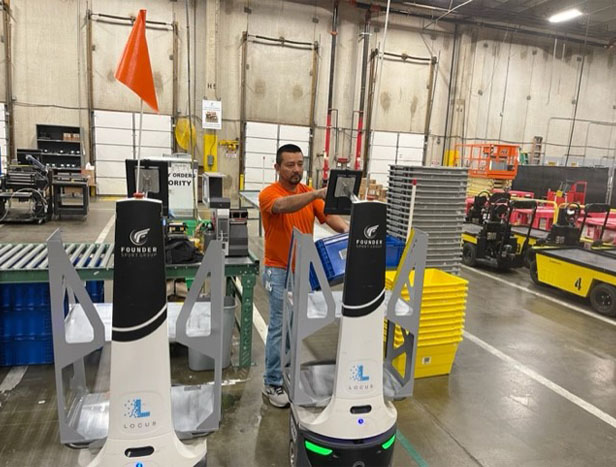News May 12, 2023
Rise of the Robots: Meet the Industry’s New AI-Powered Helpers
Signaling a new era of industry logistics, the use of autonomous mobile robots by several suppliers is boosting efficiency and safety.
Just off I-83, a bit south of Harrisburg, PA, there’s a distribution center where the future of logistics in the promotional products industry – and all of business – is taking shape.
A visitor won’t spot it when they pull into the well-kept parking lot and see employees on their lunchbreak shooting hoops. Nor is it apparent when they walk through the main entrance into an apparel showroom with the look of a retail store.
It’s only when you step into the warehouse proper and see the workers tending to their duties that the future-altering implications become apparent. No, not the humans picking items off shelves. It’s their “co-workers” – the robots. There’s a fleet of them fanning out through the facility’s city-grid-like streetscape of product-filled pallet racks, being loaded with apparel by the human employees before delivering the goods to drop-off points for packing and shipping.

Ron Wittebort, vice president of operations at alphabroder (asi/34063), with one of the supplier’s robots from Locus Robotics.
It’s here at Top 40 supplier alphabroder’s (asi/34063) distribution center in Lewisberry, PA, that a robot revolution in promo’s supply chain is underway.
“This is cutting edge for our industry,” says Ron Wittebort, vice president of operations at alphabroder. “It’s something many in our space will be looking to do.”
The Start of Something Big
Advanced working robots in the promotional products industry sounds like a fantasy. But a select few companies are already making it happen.
Alphabroder is among the small number of promo suppliers that have begun using collaborative robots in their distribution centers (DCs). BELLA+CANVAS (asi/39590) and Founder Sport Group, which includes supplier Badger Sport (asi/37876), are also deploying bots to help streamline product-picking in their warehouses.
As of this writing, alphabroder has the bots in seven of its eight U.S. distribution centers and BELLA+CANVAS features them in two DCs. Founder/Badger has instituted bots in its largest distribution center.
The suppliers all started implementing the robots within the last 18 months or so. They’ve leased the hyper-intelligent machines from Locus Robotics, a Massachusetts-based company that provides an enterprise-level warehouse automation solution. The solution centers on autonomous mobile robots (AMRs) that work in conjunction with human employees – the same machines the promo suppliers are leveraging.
ASI Media’s Christopher Ruvo chats with Ron Wittebort of alphabroder about the supplier’s use of bots at the company’s distribution center just outside Harrisburg, PA.
If you’re picturing little “Terminators” running around, don’t. That’s having a bit of fun, but is to say that the bots aren’t humanoid in appearance. Rather, the AMRs from Locus feature a front-facing main stem that connects to a wheeled base, upon which there’s an area for stacking items – like boxes – that the bots transport.
A smart pad that employees interact with for retrieving order-picking details extends off the back of the stem. The bots present information on the smart pad in more than two dozen languages – a boon when dealing with workers from a variety of backgrounds whose preferred language may not be English.
The bots operate with coordinated dynamism, working on algorithms that enable them to find the most efficient routes to travel to different pick points in a distribution center to collect products.

Bots at the ready for work. The blue spheres projecting on the floor are a safety feature that helps alert people that the bots are moving nearby.
At the alphabroder DC, the bot logistics ballet was on full display during a recent ASI Media visit.
In an induction area, an alphabroder associate scanned boxes with order-information-bearing labels into a waiting AMR. Once the bot was filled with boxes, the employee deployed it with the press of a “button” on the smart pad screen.
From there, the robot – moving at roughly 2.5 mph – traveled out into the warehouse. Blue lights at its base indicated it was in transit. As it moved, the AMR used its in-built sensing technology to navigate around people and other bots. Soon, it hung a right down an aisle of pallet racks, arriving at its first pick location.
A Locus bot works in collaboration with an alphabroder associate at the supplier’s facility in Lewisberry, PA.
The lights in the bot’s base turned green, indicating it was ready to be loaded. A nearby employee assigned to that zone of the warehouse quickly stepped up, read the order details on the pad, and picked the apparel. Thus loaded, the AMR left for its next pick site. Before it left though, it directed the employee (via smart-screen instruction) to the next closest robot for more picking. (Employees don’t follow the robots on all their stops – what Locus describes as a real game-changer for productivity.)
Such a scenario played out many times through the day, with bots efficiently and independently of each other going to and fro, working in harmony with humans. It should be noted, too, that even before the scanning process started at induction, Locus’ backend technology had communicated with alphabroder’s enterprise resource planning system to provide a labeling sequence that was most efficient, empowering the associate to load the boxes in that sequence – a productivity-enhancer.
“It doesn’t take an operations expert to see these robots are very utilitarian and present advantages,” says Norm Hullinger, chief operating officer at BELLA+CANVAS. “I believe they will become much more ubiquitous in our industry and others, especially as they become more and more affordable. We’re at the start of something big.”
The Benefits of Bots
There’s a good reason for Hullinger’s enthusiasm. Consider that the hybrid human-robot collaboration picking model has helped improve operational efficiency and ensure timeliness and accuracy across orders at BELLA+CANVAS, he says. “Our errors have gone down by 70%,” Hullinger asserts.
Accuracy and on-time delivery have increased at Founder/Badger Sport, says Dan Heyden, senior vice president of U.S. operations and wholesale channel at Founder Sport Group, which includes Badger, Alleson Athletic and others. During peak season months, the bots have helped the supplier improve its on-time same-day shipping, taking the overall percentage of on-time ships to around 99%, Heyden says. Order accuracy has risen to over 99%, he adds.
“You get a more stable and consistent workflow,” Heyden states.
“The robots are so intuitive; you can have an associate at a reasonable level of productivity in four-to-six hours instead of four-to-six weeks.” Dan Heyden, Founder Sport Group
Data fed in from the bots also affords supplier logistics leaders greater visibility into their operations, enabling the better management of everything from inventory to where products are housed in a warehouse, they say.
“The data points allow work in real time at a DC and across our entire network,” says Wittebort. “I can review reporting and live data from every location and see how things are moving along. It facilitates having operations in tune.”
As further illustration of that point, executives note that heat mapping generated through bots can show what areas of a distribution center are seeing the most activity, indicating the products there are in high demand. Drawing on such data, leaders can more quickly and strategically allocate people or even reposition where product is kept to maximize efficiency.
“We had a record year in terms of outbound sales in our stock business in 2022,” Heyden says. “That growth was in part a result of being a consistent and accurate supplier, which was helped by a strong inventory position and on-time shipping. The bots were a key component of that performance.”

Founder Sport Group, whose companies include Badger Sport (asi/37876), uses Locus bots at a distribution center.
The supplier executives ASI Media spoke with all emphasized that the AMRs have also helped drastically reduce training time for new hires. “The bots allow for new team members to be 90% effective in the first 30 minutes of training,” Hullinger shares. “In turn, we can more easily scale our operation.”
Prior to peak periods, Badger Sport would, before the bots, invest weeks of training into seasonal associates so they could be productive when the rush would hit – a process that involved the worker learning to be independent picking orders. Now, training takes a fraction of the time. “The robots are so intuitive; you can have an associate at a reasonable level of productivity in four-to-six hours instead of four-to-six weeks,” says Heyden.
Suppliers note they lease the bots and can rent additional AMRs as needed during peak times. Of course, there are costs associated with that. But overall, the bots help suppliers spend less than they would if they had to hire more permanent positions or seasonal workers and account for attrition costs tied to such folks coming and going, especially as inflation has driven steep labor rate increases in the post-COVID-shutdown era.
“This helps us keep our costs intact and be competitive in going to market,” Heyden says.
Indeed, says Wittebort, the advantages that suppliers experience ultimately result in benefits for distributors: “We’re nimbler for our customers.”
‘But… The Bots Are Replacing People, Right?’
When discussing robots, there’s always a proverbial elephant in the room: The criticism that they’re taking jobs from people.
A recent study from Brigham Young University asserted that 14% of workers say they’ve seen their job replaced by a robot. In 2020, economists Daron Acemoglu and Pascual Restrepo found that each new robot added in manufacturing in the United States between 1990 and 2007 replaced, on average, 3.3 workers nationally. That increased use of robots in the workplace also lowered wages by roughly .4% during the same time period, the study says. Similarly, various analysts believe that human headcount levels required to power on-the-floor manufacturing and distribution center operations will decline as automation advances.
Still, supplier executives say it misses the mark to see a Locus robot in their facilities and assume it has taken a job from someone. For starters, the bots can’t function independently; they need to collaborate with human associates to be useful. “The bots aren’t replacing people; they’re just helping people do their jobs,” says Hullinger.
Furthermore, a robot can’t supplant someone who was never there. Securing adequate labor levels to meet demand, especially during peak seasons, could prove a hurdle even before COVID-19. But amid the economic bounce back from the pandemic, it became a pronounced problem for promo suppliers and other distribution center operators across industries.
The COVID-period scarcity of workers was one of the motivating factors that compelled suppliers to investigate the feasibility of deploying robots. Looked at from this perspective, it’s not then that a bot has elbowed out a worker; it’s that the AMR is providing a productivity need that either would have gone unmet or, in order to be met, would have required heaping additional burden on workers already on staff. It’s filling a vacancy that was going unfilled, the thinking goes.
‘A Huge Team Effort’
It takes teams of people to get robots operational in a distribution center. After deciding in late December 2021 to implement AMRs, alphabroder (asi/34063) began collaborating with Locus Robotics to set everything in place to successfully deploy the bots in the Top 40 supplier’s distribution center in Lewisberry, just outside the Pennsylvania capital of Harrisburg. In all, about 50 people were involved, says Debby Krissinger, alphabroder’s vice president of inventory and distribution systems.
The process involved everything from creating what one can think of as digital maps of the facility for the bots to follow to extensive backend information technology work to physical alterations, like reconfiguring workstations. It all came together in several months, and the bots went to work for alphabroder in April 2022. “It was a huge team effort,” Krissinger says.
With knowledge gained through the Lewisberry implementation, alphabroder and Locus grew even more efficient as they instituted bots in the supplier’s other distribution centers throughout 2022. As of this writing, alphabroder had Locus bots in seven of its eight warehouses in the U.S. The remaining site was scheduled to go live in May.
“At first, there was anxiety from some of our team members that bots were there to take their jobs,” says Heyden. “But that’s just not the case. The reality is that the bots help support our associates and there’ve been real benefits to them as a result.”
Wittebort shares a similar perspective. Not only have the bots helped simplify and streamline employee tasks, they’ve made the warehouse workplace significantly safer and helped improve quality of life for associates, he asserts.
On safety: There are, for instance, far less pack mules – electric vehicles used to transport goods – buzzing around the warehouses, which reduces chances for injury-causing collisions. On work-life balance, the productivity and reliability of the bots helps allow for consistent schedules and standard weekly hours for human workers, reducing the need to require overtime and the like.
“We’re a safer workplace, a quieter workplace, and we have created the work-life balance that our associates were looking for. The possibility of achieving this was one of the primary reasons we looked into this automation,” says Wittebort, adding that turnover is down. Heyden echoes the point, stating that, “Post-Locus, we’re finding that retention is better.”
Eduardo Nunez, an associate at alphabroder’s Lewisberry facility, says of the bots: “It’s a great change. It’s safer – that’s the best part.”
Beyond Promo
The use of AMRs in fulfillment and distribution warehouses has grown more popular in recent years, especially as the technology has evolved and securing adequate labor levels has become a persistent, bigger challenge.
Founded nine years ago, Locus says that it has bots at more than 250 sites around the world. The firm’s clients include retailers, third-party logistics companies and specialty warehouses, such as CEVA Logistics, DHL, Material Bank, Boots UK, GEODIS, Ryder, Verst Logistics and Radial. DHL reportedly had about 2,000 Locus robots working in its facilities at the end of 2022.
75%
of large enterprises in product-centric businesses will have adopted some form of intralogistics robots in their warehouse operations by 2026.(Gartner)
“Our 5-year partnership with Locus has enabled DHL to deliver more resilient, flexible and scalable supply chain solutions to our customers to support faster delivery, improve operational efficiency and reduce employee workloads,” Sally Miller, CIO of DHL Supply Chain North America, says in a statement Locus highlighted on its website.
Locus shares that in September 2022, it scored an industry-first when one of its bots made the firm’s 1-billionth pick. It took Locus 1,542 days to pick its first 100 million units, but only 40 days for the last 100 million picks, the company reported late last year. Locus robots now average more than three million picks per day around the world, the company says.
Locus certainly isn’t the only player in the space.
Others include Ambi Robotics, whose AmbiKit solution is an advanced operating system that leverages proprietary simulation-to-reality technology to teach robots to pick and pack unique items rapidly. There’s also Agility Robotics, which offers Digit, a human-centric robot made for logistics work. With a humanoid head that features LED eyes that can blink and a person-like body with legs, arms and hands that can wave hello, Digit works in spaces designed for people, starting with bulk material handling within warehouses and distribution centers. Amazon, of course, is using bots in its operations.
This video demonstrates the evolution of Agility Robotics’ human-centric Digit offering.
“By 2026, 75% of large enterprises in product-centric businesses will have adopted some form of intralogistics robots in their warehouse operations,” says Dwight Klappich, an analyst with research/consultancy firm Gartner, in a 2022 report on smart bots. “The lower price of entry and faster time to value of robotics opens the market to more companies that can justify automation … as companies adopt robotics, most organizations will expand and scale their use of robotics within the enterprise, leading to fleet growth.”
All that has analysts predicting a rise in revenue for robot makers: Spending in the global logistics robotics market was valued at roughly $2.6 billion in 2020; it’s expected to increase at a compound annual growth rate of 22.94%, reaching an estimated $10.97 billion by 2027, according to data analysis firm Research and Markets.
Advances in technology that empower bots to perform a wider range of functions could help propel expansion, some experts believe.
Says Agility Robotics Chief Technology Officer Jonathan Hurst: “Single-purpose industrial robots have a long history in warehouses, but the past decade has seen the rise of collaborative robots – robots that can co-exist alongside people. Collaborative robots, however, largely perform one function over and over. The next decade will see a rise in multipurpose robots – those that can perform one simple task, and then also undertake a different task within the same workflow.”
From a promo perspective, it’s all by way of saying: The bots aren’t coming. They’re already here.
